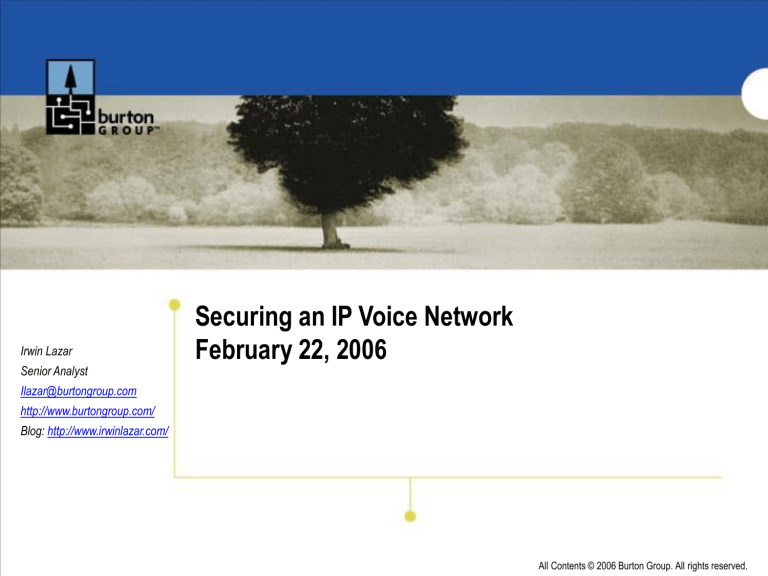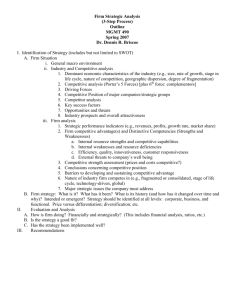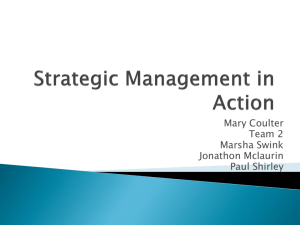BCR-VoIPSec-Webinar - Irwin Lazar's "Real

Irwin Lazar
Senior Analyst
Ilazar@burtongroup.com
http://www.burtongroup.com/
Blog: http://www.irwinlazar.com/
Securing an IP Voice Network
February 22, 2006
All Contents © 2006 Burton Group. All rights reserved.
Securing an IP Voice Network
Agenda
• Threats
• Mitigation Techniques
• Recommendations
2
Threats
The Sky Is Falling!!!
“Cisco Security Threats Serve as a VoIP Wake-Up Call”
Information Week, January 23, 2006
“Is VoIP The Cyber Criminal’s New Best Friend?”
Silicon.com, January 26, 2006
“Data and voice convergence brings host of new threats”
TechCentral, January 23, 2006
“IP Telephony Is Inherently Insecure, and since its operations depend on the Internet, all cyber vulnerabilities on the Internet threaten to knock out phone systems that use VoIP”
Cyber Security Industry Alliance, May 2005
3
Threats
Let’s Remember, The PSTN Isn’t Secure Either
• Phones & trunks can be tapped
• Toll fraud is still a concern
Qui ckTime™ and a
TIFF (U ncompr essed) decompressor are needed to see thi s pi cture.
QuickTime™ and a
TIFF (Uncompress ed) dec ompres sor are needed t o s ee this pic ture.
4
Voice Security Is As Much A Social Problem As A Technical
Problem
• Hang out in a coffee shop or airport and you’re likely to hear sensitive topics being discussed in the open
• Modern office cube farms are inherently insecure
Threats
What are the real threats?
• Denial of Service Attacks
• Against calls servers, gateways and end-points
• Eavesdropping
• Unauthorized call capture, either internally or externally
• Could also include remote speakerphone activation
• Toll Fraud
• Internal misuse or external access to call services
• Rogue phone placement
Attacks can come from inside or out
5
Threats
The Reality
• Many threats are overblown, current VoIP deployments are small, and are generally isolated from the Internet
• PSTN provides a “firebreak”
• SPIT isn’t a real threat (yet)
6
• But, this is changing
• Increasing use of public services
• Softphones
• Increasing IP-to-IP peering
Threats
SIP Trunking Example
Provider Network
SIP
Provider
Gateway
LA
PRI
PSTN
PRI
Enterprise Location
SIP
Provider
Gateway
NY
7
IP-PBX
New York
Customer Location
PBX
Los Angeles
Agenda
Agenda
• Threats
• Mitigation Techniques
• Recommendations
8
Mitigation Techniques
Operational
• Risk assessment
• Security audits
• Use of tools such as VoIP Shield to detect potential flaws
• User training
• Patch management
9
Mitigation Techniques
Technical
• Network isolation
• Voice and Data on separate VLANs
• Encryption
• Both signaling and media
• Hardening of call servers
• Host-based intrusion detection
• Closing unnecessary ports
• Hardening of end-points
• Signed software loads
• Access controls (802.1x)
• Hardening of network
• Intrusion detection
• Voice-aware firewalls
10
Mitigation Techniques
VLAN Isolation
Call Server VLAN
Call Server
Data to Data
Voice to Voice
Voice to Data
Call Server to Voice
Call Server to Data
Full
Full
Blocked
Full
Limited
Data VLAN
Subnet A
Subnet B
X
Subnet A
Subnet B
Voice VLAN
11
Agenda
Agenda
• Threats
• Mitigation Techniques
• Recommendations
12
Recommendations
• Risk assessment
• Technical best practices
• TLS/SSL for signaling
• SRTP for media
• IDS/IPS on all servers and at network connection points
• VoIP-aware firewalls to protect network zones
• Authentication of network devices
• Operational best practices
• Training
• Vulnerability testing
• Patch management
13
Recommendations
For Further Study
• Follow security developments/discussions
• VoIPSA Mailing List http://www.voipsa.org/
• Blue Box VoIPSEC Podcast http://www.blueboxpodcast.com/
• US National Institute of Technologies and Standards
(NIST) “Security Considerations for Voice over IP
Systems”
• http://csrc.nist.gov/publications/nistpubs/800-58/SP800-58-final.pdf
14







